
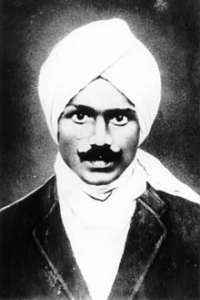
Mahakavi Subramanya Bharathiyar was born to Chinnasami Subramanya Iyer and Lakhsmiammaal as “Subbayya” on December 11, 1881 in the Tamilnadu village of Ettayapuram. He was educated at a local high school called “The M.D.T. Hindu College” in Tirunelveli. From a very young age he learnt music and at 11th, he learnt songs. It was here that he was conferred the title of “Bharathi” (one blessed by Saraswati, the goddess of learning).
Bharathi lost his mother at the age of 5 and his father at the age of 16. He was brought up by his disciplinarian father who wanted him to learn English, excel in arithmetic, become an engineer and lead a comfortable life. However, Bharathi was given to day dreaming and could not concentrate on his studies. In 1897, perhaps to instill a sense of responsibility in him, his father had the 14 year old Bharathi, married to his seven year younger cousin, Chellamal.
During his stay in Benares (also known as Kashi and Varanasi), Bharathi was exposed to Hindu spirituality and nationalism. This broadened his outlook and he learned Sanskrit, Hindi and English. In addition, he changed his outward appearance. He also grew a beard and wore a turban.
OKSR Kumaraswamy Mudaliar who was a famous freedom fighter in Tamil Nadu and he was born on 04-10-1904 in the small down named as Chennimalai in Tiruppur District of Tamil Nadu. He was popularly known as Tiruppur Kumaran. He involved himself in the Indian freedom movement in his young age and he participated in many struggles in the Indian freedom movement.
Vanchinathan (1886 – June 17, 1911) , popularly known as Vanchi, was an Indian Tamil independence activist. He is best remembered for having shot dead Ashe, the Collector of Thirunelveli and having later committed suicide in order to evade arrest.
Vanchinathan was born in 1886 in Shenkottai to Raghupathy Iyer and Rukmani Ammal. His actual name was Shankaran. He did his schooling in Shenkottai and graduated in M.A. from Moolam Thirunal Maharaja College in Thiruvananthapuram. Even while in college, he married Ponnammal and got into a lucrative Government job.
Veerapandiya Kattabomman also known as Katta Bomman was an 18th century Indian Palaiyakkarar chieftain from Panchalankurichi and who was one of the earliest to oppose the British rule. He waged a war with the British six decades before Indian War of Independence which occurred in 1857 in Northern parts of India. After a bloody war with the British he was captured by British and hanged in 1799 CE. His fort was destroyed and his wealth looted by the British army. Today Panchalankurichi is a historically important place in the present day Thoothukudi district of Tamil Nadu state, India.
Veerapandiya Kattabomman was born to Jagaveera Kattabomman and Arumugathammal on January 4, 1760. He had two younger brothers Dalavai Kumarasami and Duraisingam. Veerapandiyan was fondly called ‘Karuthaiah’ (the black prince), and Dalavai Kumarasami, ‘Sevathaiah’ (the white prince). Duraisingam, a good orator, was nicknamed ‘Oomaidurai’ meaning the Mute Prince.
Azhagiya Veerapandiapuram (Otta-pidaram of today) was ruled by Jagaveera Pandiyan. He had a minister Bommu, also a brave warrior, who was known as Getti-bommulu in Telugu, after the god Sastha Ayyappan Swamy to describe his strength and fighting qualities which over a period of time, became Kattabomman in Tamil. Katta-bomman ascended the throne after Jagaveera Pandiyan, who had no issue, as Adi Kattabomman, the first of the clan of Katta-bomman.
Legend has it that during a hunting trip into the forests of Salikulam (close to Azhagiya Pandiyapuram) one of the Kattabommans watched the spectacle of a hare chasing seven hounds. Kattabomman was amazed at this miracle. Believing that the land possessed great powers that could instil courage in people, he built his fort there and named it Panchalankurichi.
On February 2, 1790, Veerapandiyan, 30, became the king of Panchalankurichi as Veera Pandia Kattabomman supposed to be the 47th ruler of the region and the 5th ruler from the Kattabomman clan and a Palya-karrar (or Polygar) of the Madurai Nayak kingdom.
After the collapse of the Vijayanagara Empire in the mid-16th century, their governors of Tamil Nadu, declared independence and established independent kingdoms. The old Pandiya country came to be governed by Naicker rulers in Madurai, who in turn divided their territories into 72 Palayams. These 72 Palayams were franchised to a Palayakarrar (Tamil word) or Polygar or Poligar (a British Term), who had to administer their territories, collect taxes, run the local judiciary, and maintain a battalion of troops for the Naicker rulers. Their function was a mixture of military governance and civil administration.
The regional/local chieftains and rulers who were earlier subordinates to the Madurai Kings became Polygars (or Palaya-karrar)
The Nayak rule in Madurai which controlled the entire West Tamil Nadu after two centuries came to an abrupt end in 1736 when Chanda Sahib of Arcot seized the Madurai throne from the last queen of Madurai in an act of treason. Chanda Sahib was later killed after the Carnatic Wars and the territory came under the Nawab of Arcot. The Palaya-karrars of the old Madurai country refused to recognize the new Muslim rulers driving the Nawab of Arcot to bankruptcy, who also indulged in lavishes like building palaces before sustaining his authority in the region.
Finally the Nawab resorted to borrowing huge sums from the British East India Company, erupting as a scandal in the British Parliament. The Nawab of Arcot finally gave the British the right to collect taxes and levies from the southern region in lieu of the money he had borrowed. The East India Company took advantage of the situation and plundered all the wealth of the people in the name of tax collection. They even leased the country in 1750’s to a savage warrior Muhammed Yusuf Khan (alias Marutha Nayagam), who killed many of the Polygars including and later got himself killed by the Arcot British forces.
Many of the Polygars submitted, only with the exception of Katta-bomman.
Kattabomman refused to pay his dues and for a long time refused to meet Jackson the Collector of the East India Company. Finally, he met Jackson at Ramalinga Vilasam, the palace of Sethupathi of Ramanathapuram. The meeting turned violent and ended in a skirmish in which the Deputy Commandant of the Company’s forces, Clarke was slain. Kattabomman and his men fought their way to freedom and safety, but Thanapathi Pillai, Kattabomman’s secretary was taken prisoner.
The Commission of Enquiry that went into the incident fixed the blame on Jackson and relieved him of his post, thinking the Company’s plan to take over the entire country gradually could be marred by Jackson’s fight with Veerapandiya Kattabomman.
The new Collector of Tirunelveli wrote to Kattabomman calling him for a meeting on 16 March, 1799. Kattabomman wrote back citing the extreme drought conditions for the delay in the payment of dues and also demanded that all that was robbed off him at Ramanathapuram be restored to him. The Collector wanted the ruling house of Sethupathis to prevent Kattabomman from aligning himself with the enemies of the Company and decided to attack Kattabomman.
The British also instigated his long time feuding neighbor Ettayapuram Poligar to make provocative wars over Kattabomman on their long pending territorial disputes.
Kattabomman refused to meet the Collector and a fight broke out. Under Major Bannerman, the army stood at all the four entrances of Panchalankurichi’s fort. At the southern end, Lieutenant Collins was on the attack. When the fort’s southern doors opened, Kattabomman and his forces audaciously attacked the corps stationed at the back of his fort, and slew their commander Lt. Collins.
The British after suffering heavy losses, decided to wait for reinforcements and heavy artillery from Palayamkottai. Sensing that his fort could not survive a barrage from heavy cannons, Kattabomman left the fort that night.
A price was set on Kattabomman’s head. Thanapathi Pillai and 16 others were taken prisoners. Thanapathi Pillai was executed and his head perched on a bamboo pole was displayed at Panchalankurichi to demoralise the resisters. Soundra Pandian Nayak, another rebel leader, was brutally done to death by having his brains dashed against a village wall.
Veerapandiya Kattabomman hid in so many places including thirumayam, virachilai and finally stayed at Kolarpatti at Rajagopala Naicker’s house where the forces surrounded the house. Kattabomman and his aides fled from there and took refuge in the Thirukalambur forests close to Pudu-k-kottai. Bannerman ordered the Raja of Pudukkottai to arrest Kattabomman. Accordingly, Kattabomman was captured and on October 16, 1799 the case was taken up (nearly three weeks after his arrest near Pudukkottai).
After a summary trial, Kattabomman was hanged unceremoniously on a Tamarind tree in Kayathar (near Thirunelveli).
Some of the other noteworthy persons who were hanged along with Kattabomman were Veeraghechayan Naicker, Dali Ethalappa Naicker and Palayakarrars of Kaadalkudi, Nagalapuram Puthur, Vripachy, Sivagangai, to death by hanging on charges of treason.
The Fort of Panchalankurichi was razed to the ground and all of Kattabomman’s wealth was looted by the English soldiers. Few years later, after the second Polygar war, the site of the captured fort was ploughed up and sowed with castor oil and salt so that it should never again be inhabited by the orders of the colonial government.
In subsequent years, a good deal of legend and folklore developed around Kattabomman and the Marudu Brothers. Kayatharu, where Kattabomman was executed has remained a place of political pilgrimage.
In his Tinnevelly Gazetteer of 1917, H. R. Pate notes the presence, in Kayatharu, of “a great pile of stones of all sizes, which represents the accumulated offerings by wayfarers of the past hundred years. Folk songs recalling the heroism of the Poligar leaders remain alive in Tamil Nadu to this day…”
The popular Tamil slang for a traitor or committing treason is Ettapa or Ettapan, courtesy the Ettayapuram Polygar whom the British later conferred the title of Raja. But it is disputed that Ettapan committed treason Kattabomman was arrested by King of Pudukottai. The Campa Cola ground in Chennai belongs/belonged to Ettappan family. Lately there is cry that unfair portrayal of Ettappan in the film Kattabomman in which actor Sivaji Ganesan gave a great performance, is the main cause for this. It seems that Ma.Po.Si(Ma.Po.Sivanyanam) who wrote the dialogues for the film had some misunderstanding with the Ettappan family.
6. V.O. Chidambaram Pillai
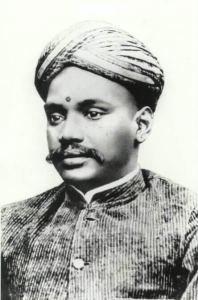
V.O. Chidambaram Pillai, popularly known by his initials, V.O.C, Va Voo Cee, Kappal Oottiya Tamilzhan, was an Indian freedom fighter born on 5 September 1872 in Ottapidaram, Tirunelveli district of Tamil Nadu State of India. He was a prominent lawyer, and a trade union leader. He gets credit for launching the first indigenous Indian shipping service between Turicorin and Colombo with the Swadeshi Steam Navigation Company, competing against britis ships. He was an Indian National Congress (INC) member, later charged with sedition by the British government and sentenced to life imprisonment; his barrister license was stripped. He is also known as “Kappalottiya Tamilan”.
Vulaganathan Othapidaram Chidambaram Pillai or V.O.C was born on 05 September 1872 to an eminent lawyer Vulaganathan Pillai and Paramyee in Ottapidaram, Tirunelveli district of Tamil Nadu state in India. After completing schooling in Othapidaram and Tirunelveli he worked for a few years in the Othapidaram district administrative office. Later following his father’s footsteps he completed law.
As a lawyer he often pleaded for the poor, at times appearing against his father, who appeared for the affluent. Among his notable cases, he proved corruption charges on three sub-magistrates. In the Kulasekaranallur Asari case he proved innocence for the accused.
In the 1890s and 1900s India’s independence movement and the Swadeshi movement, initiated by Bal Gangadhar Tilak and Lala Lajpat Rai of Indian National Congress (INC), were at their peak. Mahatma Gandhi was yet to land in India. They were against the British Imperial coercion of trade, which was damaging traditional Indian industries and the communities dependent on them. They are the essence of the Swadeshi movement. In Madras Presidency the Independence movement was championed by the likes of Subramanya Siva, the poet Subramanya Bharathi, and Aurobindo Gosh later to be joined by V.O.C He entered politics in 1905 following the partition of Bengal, joining the Indian National Congress and taking a hardliner stand. He also presided at the Salem District Congress session.
V.O.C., drawing inspiration from Ramakrishnananda, a disciple of Swami Vivekannanda, resorted to Swadeshi work. Following requests by local citizens, he initiated steps to break the monopoly of British shipping in the coastal trade with Ceylon.
On 12 November 1905, V.O.C. formed the Swadeshi Steam Navigation Company, by purchasing two steamships ‘S.S. Gaelia’ and ‘S.S. Lawoe’, thanks to the assistance and support of Lokamanya Bal Gangadhar Tilak and Aurobindo Ghose. The ships commenced regular service between Turicorin and Colombo (Srilanka), against the opposition of the British traders and the Imperial Governmetn. V.O.C. was thus laying the foundation for a comprehensive shipping industry in the country, more than just a commercial venture.
Until then the commerce between Tuticorin and Colombo was a monopoly enjoyed by the British India Steam Navigation Company (BISN). This was later to be merged with P&O lines and its Tuticorin agents, A & F. Harvey.
His efforts to widen the base of the Swadeshi movement, by mobilizing the workers of the Coral Mills (also managed by A. F. Harvey) brought him into increasing conflict with the British Raj. On 12 March 1908, he was arrested on charges of sedition and for two days, Tirunelveli and Tuticorin witnesses’ unprecedented violence, quelled only by the stationing of a punitive police force. But newspapers had taken note of VOC. Autobindo Ghosh, acclaimed him in Bande Mataram (March 27, 1908)
“Well Done, Chidambaram! A true feeling of comradeship is the salt of political life; it binds men together and is the cement of all associated action. When a political leader is prepared to suffer for the sake of his followers, when a man, famous and adored by the public, is ready to remain in jail rather than leave his friends and fellow workers behind, it is a gign theat political life in India is becoming a reality. Srijut Chidambaram Pillai has shown throughout the Turicorin affair a loftiness of character, a practical energy united with high moral idealism which show that the is a true Nationalist. His refusal to accept release on bail if his fellow-workers were left behind is one more count in the reckoning. Nationalism is or ought to be not merely a political creed but a religious aspiration and a moral attitude. Its business is to build up Indian character by educating it to heroic self-sacrifice and magnificent ambitions, to restore the tone of nobility which it has lost and bring back the ideals of the ancient Aryan gentleman. The qualities of courage, frankness, love and justice are the stuff of which a Nationalist should be made. All honor to Chidambaram Pillai for having shown us the first complete example of an Aryan reborn, and all honor to Madras which has produced such a man”.
The British had assumed the Indian venture would collapse like a house of cards, but soon found the Indian company to be a formidable challenge. To thwart the new Indian company they resorted to the monopolistic trade practice of reducing the fare per trip to Re.1 (16 annas) per head. Swadeshi company responded by offering a fare of Re. 0.5 (eight annas). The British company went further by offering a free trip to the passengers plus a free umbrella, which had ‘S.S. Gaelia’ and ‘S.S. Lawoe’ running nearly empty. By 1909 the company was heading towards bankruptcy.
To widen the Swadeshi base and to create awareness of British Imperialism V.O.C. became instrumental in mobilizing the workers of Coral Mills (also managed by A. & F. Harvey) (now part of Madura Coats) in Tirunelveli. This brought him into increasing conflict with the British Raj. On 12 March, 1908, he was arrested on charges of sedition and for two days, Tirunelveli and Tuticorin witnessed unprecedented violence, quelled only by shooting four people to deah (a Muslim, a Dalit, a baker and a Hindu temple priest). Punitive police forces were brought in from neighboring districts.
- But newspapers had taken not of V.O.C. Sri Aurobindo’s nationalist Bengali newspaper Bande Mataram (splet and pronounced as Bonde Matorom in the Bengali language) acclaimed him (March 27, 1908) with “Well Done, Chidambaram”. Apart from the Madras press, Ananad Bazaar Patrika from Koldata (Calcutta) carried reports of his prosecution every day. Funds were raised for his defence not only in India but also by the Indians in South Africa.
Apart from the Madras press, Ananad Bazaar Patrika from Koldata (Calcutta) carried reports of his prosecution every day. Funds were raised for his defence not only in India but also by the Indians in South Africa. Bharathy gave evidence in the case which had been instituted against him. V.O.C was confined in the Central Prison, Coimbatore from 9 July 1908 to 1 December 1910.
7. Dheeran Chinnamalai
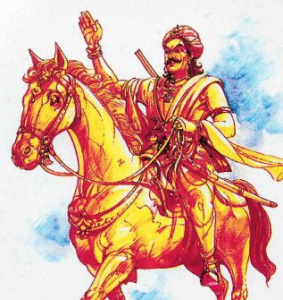
Dheeran Chinnamalai was an Indian revolutionary and chief of Kongu Nadu who revolted against the supremacy of British rule in India. He was a Palayakkarar in Tamil Nadu who fought against the British Easy India Company in the 18th century B. C.
He was born on 17th April 1756 in Melapalayam near Erode in Tamil Nadu. His birth name was Theerthagiri Sarkkarai Mandraadiyaar. He belonged to the famous Palaiya Kottai Pattakarar family. His parents are Rathnaswamy and Periyaatha. He had four brothers, Kudandiswamy, Thambi, Kilothar and Kuttiswamy and one sister Parvatham.
He got good training of Silambu and archery. He headed a huge army that fought in the Second Polygar War in 1801 to 1802. In late 1700s he Kongu Nadu was controlled by Mysore King Hyder Ali. When the diwan of Hyder Ali came to collect taxes from the farmers, he with his brothers seized the entire tax collected and distributed them back to the farmers. This incident took place between Sivan Malai and Chennimalai. He refused to accept the supremacy of Hyder Ali.
After the death of Hyder Ali on 12th July 1782, his son Tipu Sultan became the king of Mysore. He helped Tipu Sultan to gain victory in the battles at Chitheswaram, Mazahavalli and Srirangapatna by providing a big army of soldiers. More than 1000 Kongu Tamils joined the regiment of Tipu. After the death of Tipu he settled at Odanilai and fought with British at Cauvery, Odanilai and Arachalur.
As Dheeran Chinnamalai was running his own kingdom and did not respect the rules and regulations of the British East India Company they were annoyed. So they sent Colonel Makistan and his men to arrest him. Chinnamalai fought against him and won the battle. Again Captain Harris was sent to capture him. By his intelligence Chinnamalai was able to win this time also.
Velappan in the British army acted as an informer to Dheeran Chinnamalai. Later he was shot dead. After that the British arrested him and his brothers and kept them in the prison at Sankagiri. When they were asked to accept the rule of British they refused and so they were hanged by rope at the top of the Sankagiri fort on 31st July 1805.
8.Subramaniya Siva

Subramaniya Siva was an Indian freedom fighter. He was a revolutionary and had to spend many years in prison. He was also a versatile writer and has written many books. He was born on 4th October 1884 in Vathlagundu town of Dindigul district of the then Madras Presidency. His father was Rajam Iyer and he was his eldest son.
He followed the traits of Bala Ganghadhara Tilak. V. O. Chidambaram and Subramanya Bharathi are his contemporaries. He disagreed with Gandhiji and his non-violence attitude. He believed that only violence could counteract violence and so he adapted revolutionary methods of showing protest.
He was married and was survived by his son Sabhapathi Sharma. He was arrested in 1908 and 1922 for his anti-political activities. He wrote a book named Jail Life which gives an account of his life in prison. He was the author of the journal Gnana Bhanu which contains the collection of poetry.
He was a devotee of Swami Vivekananda and Sri Ramakrishna Paramahamsa. He wrote the books Ramanuja Vijayam and Madhya Vijayam. He wanted to create enlightenment among people through his dramas and bhajans.
He chose Papparapatti village in Pennagaram taluk for his activities. In 1921 he came to Papparapatti and tried to establish Bharatashram there which was not successful. He was suffering from leprosy when he was in prison. In those days leprosy was considered to be a contagious disease and many restrictions were imposed on him by the British Government. He was not allowed to travel in trains. In spite of these difficulties he walked on foot to many places and continued his struggle for Indian independence.
He was the first political prisoner in the Madras jail. He died on 23rd July 1925 and his Samadhi is situated in Papparapatti. Dindugul district collector office and Vathlagundu Bus Stand were named after him. In 2010 it was announced by the Government of Tamil Nadu that a memorial would be established for him in Papparapatti.
9.The Maruthu Pandiyar
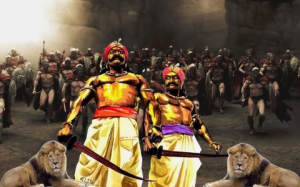
The Maruthu Pandiyar brothers (Periya Maruthu & Chinna Maruthu) ruled Sivagangai, Tamil Nadu during the last part of the 18th century and they were the first to issue a proclamation of independence from the British rule from Trichy Thiruvarangam Temple, Tamil Nadu on June 10, 1801, which is 56 years before the North Indian rebellion – Sepoy mutiny of 1857.
In the year 1772, the English military of the East India Company, under the command of Lt.Col. Bon Jour attacked the state at Kalayar Kovil. As the war worsened, Raja Muthu Vaduganadhar lost his life on the spot. But the Maruthu brothers managed to escape along with Rani Velu Nachiar, wife of Raja Muthu Vadughanadhar and arrived at Dindigul which was ruled by Hyder Ali – the Sultan of Mysore as refugees. Hyder Ali supported them with all respects.
Arcot Nawab, the alliance partner of East India Company was not able to collect any taxes from the people of Sivaganga state for eight years, arranged for an agreement whereby the rule of Sivaganga was restored to Rani Velu Nachiar after he collected his dues from her. The Marudu brothers with 12,000 armed men surrounded Sivaganga and plundered Arcot Nawab’s territories. The Nawab on the 10th of March 1789 appealed to the Madras Council for aid. On 29th April 1789, the British forces attacked Kollangudi. It was defeated by a large body of Marudu’s troops.
They were in close association with Veera Pandiya Kattabomman of Panchalankurichi. Kattabomman held frequent consultations with Marudhus. After the execution of Kattabomman in 17th October 1799 at Kayattar, Chinna Marudhu gave asylum to Kattabomman’s brother Oomadurai (dumb brother). But, the British took this reason to invade and attacked Sivaganga in 1801 with a powerful army. The Maruthu Pandiyars and their allies were quite successful and captured three districts from the British. British considered it as a serious threat to their future in India that they rushed additional troops from Britain to put down Maruthu Pandiyars’ rebellion. These forces surrounded Maruthu Pandiyars’ army at Kalayar Koil, and the latter scattered. The Maruthu Brothers and their top commanders escaped. They regrouped and fought the British and their allies at Viruppatchi, Dindigul and Cholapuram. While they won the battle at Viruppatchi, they lost the other two battles.
10. Puli Thevar
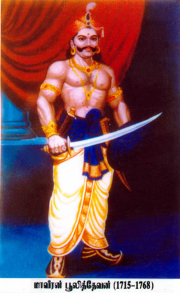
Puli Thevar was a poligar (or palayakarar) who ruled Nerkattumseval situated in the Sankarankoil taluk of Tamil Nadu. Puli Thevar who belongs to the warrior Maravar community was one of the earliest freedom fighters. He is one of the first Indian kings to have fought and defeated the British in India.
He is one of the earliest opponents of the British rule in South India. He was involved in a vendetta with the Nawab of Arcot who was supported by the British. Thevar’s prominent exploits were his confrontations with Marudhanayagam, who later rebelled against the British in the late 1750s and early 1760s.
Nelkatumseval was the headquarters of Puli Thevar, the first chieftain in India to resist the British.The author of the Thirunelveli District Gazetteer, H.R. Pate, observes as follows:
Nelkatumseval is chiefly memorable as having been in the eighteenth Century stronghold of the redoubtable Puli Thevar, who figured for many years as the leader of the Marava Confederacy against the troops of the Nawab and the Company. He had a shrewd insight into the political situation of the time and was a veritable thorn against the side of the Nawab’s agents.
Pulithevar remains one of the illustrious figures in the chequered history of palayakarars. The vivacity of his character gave him an ascendancy over the western palayakarars, while his determined resistance to the Nawab’s overlordship made him a potential enemy of the Wallajahs. He was the principal architect of the coalition of the palayakkars organised against the Nawab. The Nawab acknowledged his victory by presenting him with a gold plate and sword.
Pulithevar is regarded as the first ruler in Indian history, who sowed the seed, by his gallant resistance, to expel foreigners from his native land. His services to the nation are honoured; the government of Tamil Nadu has erected a memorial for him in Nelkatumseval where there are the remnants rin



